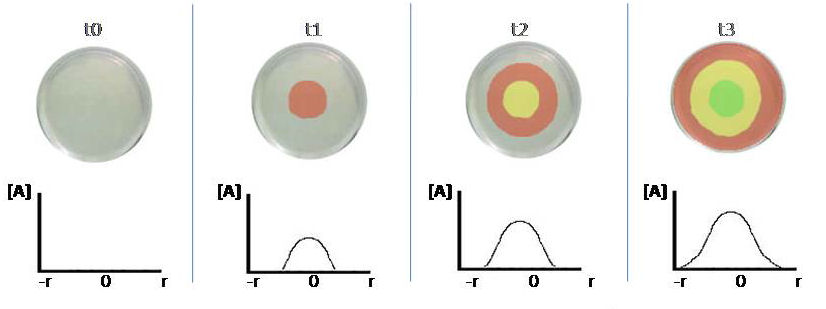Mexican Wave
From 2007.igem.org
(Difference between revisions)
Sinem saka (Talk | contribs) (→Project 1 Mexican Wave) |
Sinem saka (Talk | contribs) (→Project 1 Mexican Wave) |
||
| Line 4: | Line 4: | ||
* Our first thought was to create a pattern by the change of colors (by production of different fluorescent proteins) triggered by a signalling protein in a concentration dependent manner; so that the production of a protein as a result of the processing of a separete system, would trigger the pattern formation, just like a goal triggering a *Mexican wave in soccer games. | * Our first thought was to create a pattern by the change of colors (by production of different fluorescent proteins) triggered by a signalling protein in a concentration dependent manner; so that the production of a protein as a result of the processing of a separete system, would trigger the pattern formation, just like a goal triggering a *Mexican wave in soccer games. | ||
| - | * The idea was to have a plate having a lawn of cloned E. coli cells having 3 constructs. Each construct would have a promoter, which would be activated by a different level of the initial signal protein, and a coding part for a reporter fluorescent protein. | + | * The idea was to have a plate having a lawn of cloned E. coli cells having 3 constructs. Each construct would have a promoter, which would be activated by a different level of the initial signal protein, and a coding part for a reporter fluorescent protein. In the figure below, red is represented to be the most sensitive reporter, activated by the lowest concentration. Yellow is sensitive to only a higher concentration and green requires the highest concentration, |
| - | * The triggering protein (say protein A) would be dropped at the middle of the plate, creating a concentration gradient on the plate as it diffuses. According to this, the color change | + | * The triggering protein (say protein A) would be dropped at the middle of the plate, creating a concentration gradient on the plate as it diffuses. According to this, the color change woulld be for once, and as concentration of A rises in time first at the middle then towards the edges, the colors will alternate from red to yellow to green, and eventally all plate will become green. |
[[Image:taslak.jpg]] | [[Image:taslak.jpg]] | ||
Latest revision as of 03:16, 27 October 2007
Project 1 Mexican Wave
FIRST VIEW
- Our first thought was to create a pattern by the change of colors (by production of different fluorescent proteins) triggered by a signalling protein in a concentration dependent manner; so that the production of a protein as a result of the processing of a separete system, would trigger the pattern formation, just like a goal triggering a *Mexican wave in soccer games.
- The idea was to have a plate having a lawn of cloned E. coli cells having 3 constructs. Each construct would have a promoter, which would be activated by a different level of the initial signal protein, and a coding part for a reporter fluorescent protein. In the figure below, red is represented to be the most sensitive reporter, activated by the lowest concentration. Yellow is sensitive to only a higher concentration and green requires the highest concentration,
- The triggering protein (say protein A) would be dropped at the middle of the plate, creating a concentration gradient on the plate as it diffuses. According to this, the color change woulld be for once, and as concentration of A rises in time first at the middle then towards the edges, the colors will alternate from red to yellow to green, and eventally all plate will become green.
SECOND VIEW
- The second view was to make this color change continuous and independent of a concentration gradient gradient created by us. So first idea came up to be coupling this oscillation to an already oscillating protein in the cell, such as a cell cycle protein. But then this oscillation will be observable only on a single cell unless we synchronize the cell cycles of different cells on the plate.
